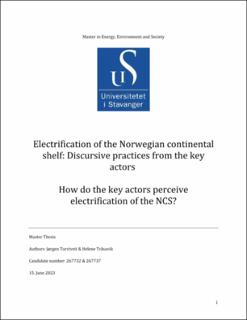| dc.description.abstract | A ‘renationalisation’ of Norwegian climate policy, shifting from a global to a domestic approach to meet a 55 % emissions reduction target, also centres the debate towards Norway's biggest emitters of greenhouse gases: the petroleum industry on the Norwegian continental shelf. Just what exactly does “all emissions cuts to be made at home” mean for the petroleum industry? A question to which the industry proposes electrification of the Norwegian continental shelf as a preferred strategy and solution to the problem of increasing emissions. Norway's economic dependency on the petroleum industry also adds to the tension in this respect. As a climate policy topic, it captivates industry actors, politicians, environmental organisations, state bureaucracy, and the public. According to discourse theory, discourses carry a significant role in societal power structures. Thus, a perspective on the discursive practices of key industry actors, politicians, policy makers, and environmental organisations can provide valuable insights to nudge the transition towards the necessary measures to meet the emissions reduction target.
The thesis executes three angles of inquiry: 1. looking at the Norwegian climate policy (both past and current) and how the electrification of the Norwegian continental shelf arises as a strategy; 2. the discursive practices and story lines of central actors within the field of electrification; and 3. the official climate policies on electrification as a strategy to reach climate targets. With these inquiries, the study aims to give insights into whether and to what extent the electrification of the Norwegian continental shelf is an appropriate measure to reach the 55 % emission cuts target by 2030. We adopt a discourse analysis framework and approach to our study, consisting of 13 key actor interviews and document analysis to detect story lines and discourses on the topic. The analysis finds many narratives that are categorised and condensed into five main story lines, one of which emerges as dominant. Based on the interviews with representatives from central actors, in addition to document analysis surrounding topic, the five storylines are:
SL1: Full on electrification
SL2: Electrification, yes, but?
SL3: Yes, but by other means
SL4: Shut it down!
SL5: Forget About Norway!
The first four story lines focus on reductions in CO2 emissions in Norway, while the fifth focuses on the international mechanisms of purchasing CO2 quotas abroad, instead of taking national emission reductions. We therefore find that most actors in our study argue for reducing emissions nationally, instead of using the international mechanism, which is a shift from the early 2000s. The study finds the second storyline, “Electrification, yes, but?” as dominant and almost hegemonic. Given its support by the most influential parties in parliament, on both sides of the political left-right spectrum, it's embedded in the state bureaucracy and can gain support from the SL1 and SL3 storylines. The SL2 storyline is a sort of middle-ground storyline that seems strategic in its purpose, due to its great flexibility to those who must defend their actions regarding electrification.
The thesis finds enabling and constraining aspects in the dominant story line, as well as discourse coalition and institutionalisation, consistent with certain characteristics of discourses. Furthermore, the study finds the discourse around the electrification of the Norwegian continental shelf to be volatile and abundantly dynamic, of which many actors have changed their position in the last decade. The concluding remarks of the thesis find that the dominant storyline, although influenced by factors such as prices on CO2 emissions and electricity prices, also falls subject to some nuances of greenwashing, legitimising oil and gas activities in the domestic political landscape as a way of securing a “license to operate”.
| |
